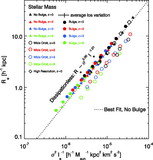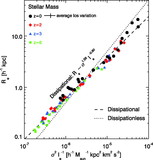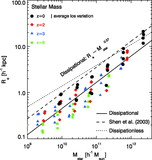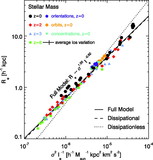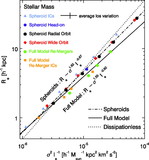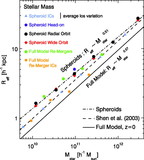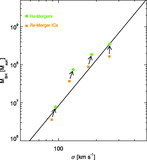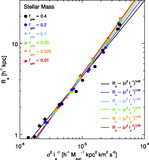Image Details

Caption: Fig. 6.
ReM![]() relation produced by the merging of gas‐rich disk galaxies with dark matter halos, star formation, supernova feedback, and a prescription for feedback from accreting supermassive black holes. Shown are remnants produced by mergers appropriate for redshifts ﹩z=0﹩ (black circles), ﹩z=2﹩ (red diamonds), ﹩z=3﹩ (blue triangles), and ﹩z=6﹩ (green squares) with nearly radial, parabolic orbits. Also plotted are remnants produced by varying the system angular momentum through the initial disk orientation (purple pentagons) and pericentric passage distances (orange hexagons) for a single pair of progenitor models, which produces a spread in the remnant effective radius. The merging of pure disk galaxies using our full physical model produces a Re‐M
relation produced by the merging of gas‐rich disk galaxies with dark matter halos, star formation, supernova feedback, and a prescription for feedback from accreting supermassive black holes. Shown are remnants produced by mergers appropriate for redshifts ﹩z=0﹩ (black circles), ﹩z=2﹩ (red diamonds), ﹩z=3﹩ (blue triangles), and ﹩z=6﹩ (green squares) with nearly radial, parabolic orbits. Also plotted are remnants produced by varying the system angular momentum through the initial disk orientation (purple pentagons) and pericentric passage distances (orange hexagons) for a single pair of progenitor models, which produces a spread in the remnant effective radius. The merging of pure disk galaxies using our full physical model produces a Re‐M![]() relation roughly parallel to that measured for massive galaxies in the SDSS (Shen et al. 2003), although with an offset. The resultant Re‐M
relation roughly parallel to that measured for massive galaxies in the SDSS (Shen et al. 2003), although with an offset. The resultant Re‐M![]() relation shifts downward with the redshift of the progenitor systems as the remnants decrease with size. For comparison, the best least‐squares fit to the Re‐M
relation shifts downward with the redshift of the progenitor systems as the remnants decrease with size. For comparison, the best least‐squares fit to the Re‐M![]() relation delineated by these remnants (solid line), as well as the dissipationless disk model Re‐M
relation delineated by these remnants (solid line), as well as the dissipationless disk model Re‐M![]() relation (dotted line) and the Shen et al. (2003) relation (dashed line) are plotted. Also shown is the mean deviation induced by line‐of‐sight variations in projected quantities for a given remnant (detached error bars).
relation (dotted line) and the Shen et al. (2003) relation (dashed line) are plotted. Also shown is the mean deviation induced by line‐of‐sight variations in projected quantities for a given remnant (detached error bars).
Copyright and Terms & Conditions
© 2006. The American Astronomical Society. All rights reserved. Printed in U.S.A.


